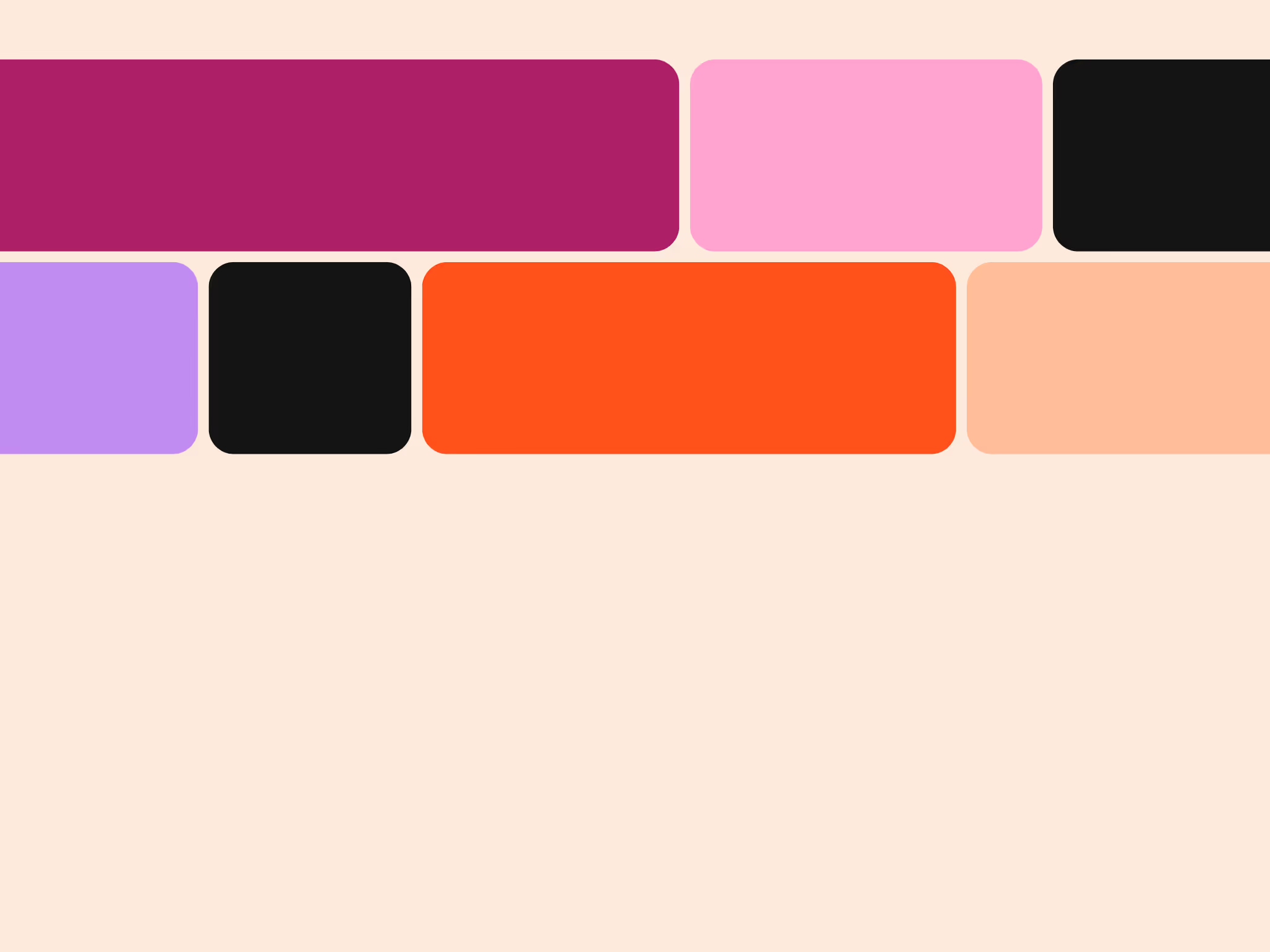You’re exhausted by the one-off influencer partnerships. Even if you hire an influencer for a whole campaign, the relationship barely lasts beyond a few posts.
What’s worse? You see the same influencers who worked with you accepting deals from your competitors and marketing their products alongside yours.
You want to grow beyond influencer marketing and scale your efforts. You’re even ready to provide true cheerleaders of your brand a raise in compensation to get a deeper commitment for your company in return.
If you’re nodding along, building a brand ambassador program is the perfect choice for you.
What is a brand ambassador program?
A brand ambassador program is a marketing strategy that uses long-term partnerships with people who love your products or services to grow sales & awareness.
Think of brand ambassadors like your loyal friends and die-hard fans. They promote your product on social media, recommend it to friends and family, and advocate for your values.
For example, PUMA recently signed the five-time Olympic champion Elaine Thompson-Herah as their brand ambassador.
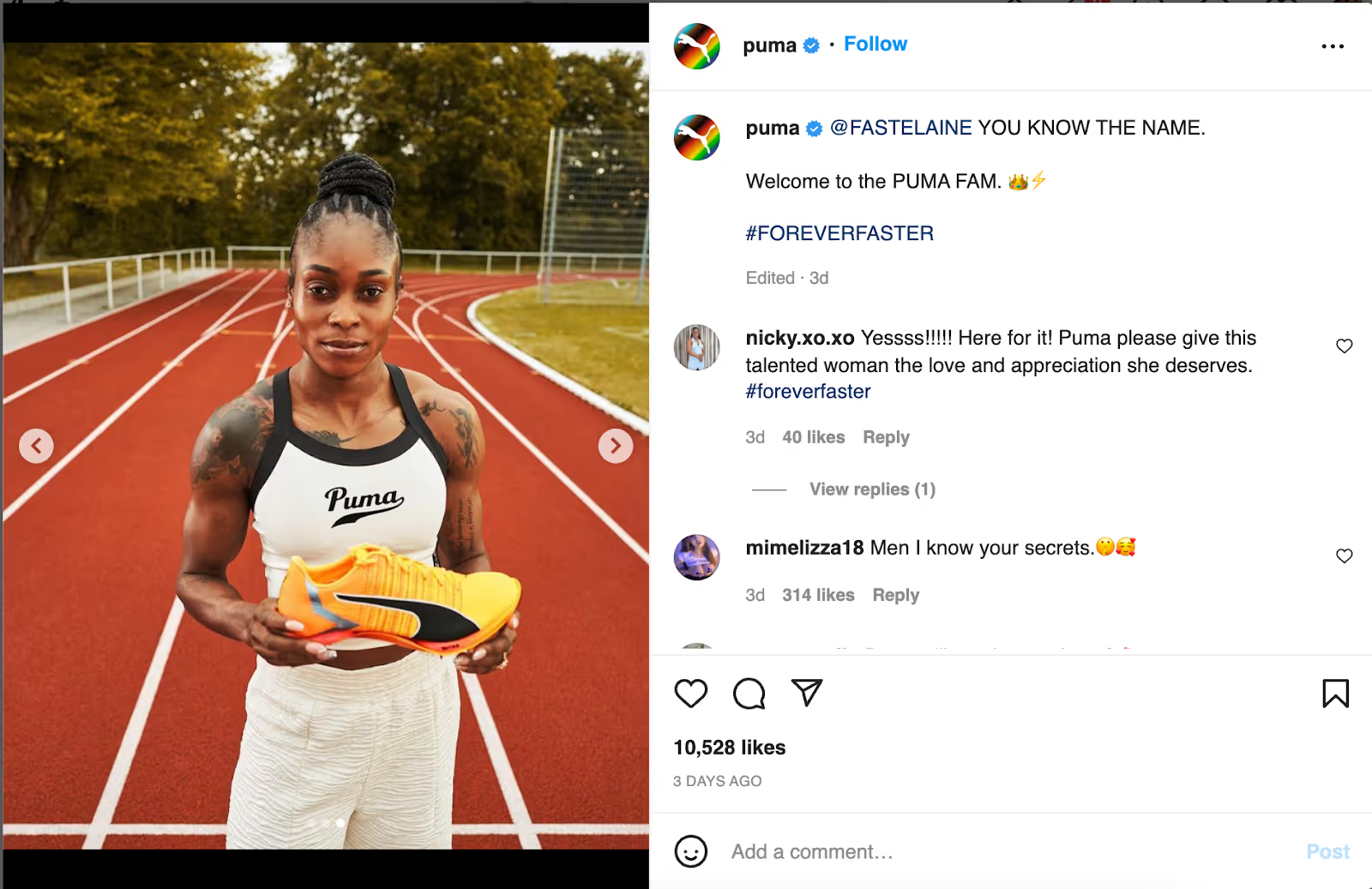
Other common examples include Gigi Hadid for Tommy Hilfiger and Hailey Bieber for Tiffany.
But a brand ambassador doesn’t need to be a celebrity or someone with millions of followers online.
Types of ambassador programs: who can be your brand ambassador?
A brand ambassador is a long-term spokesperson for the company — whether they are Hollywood stars, loyal customers, or social media influencers.
The various types of brand ambassadors include:
Customers
Loyal customers often share unsolicited enthusiasm for your brand and are genuine fans of your products. They already believe in your brand and buy from you — making them the perfect representation for your company. Athleisure brand Lululemon welcomes global and local brand ambassadors with the only criteria that they are ‘sweaters’ — people who work hard at what they do.
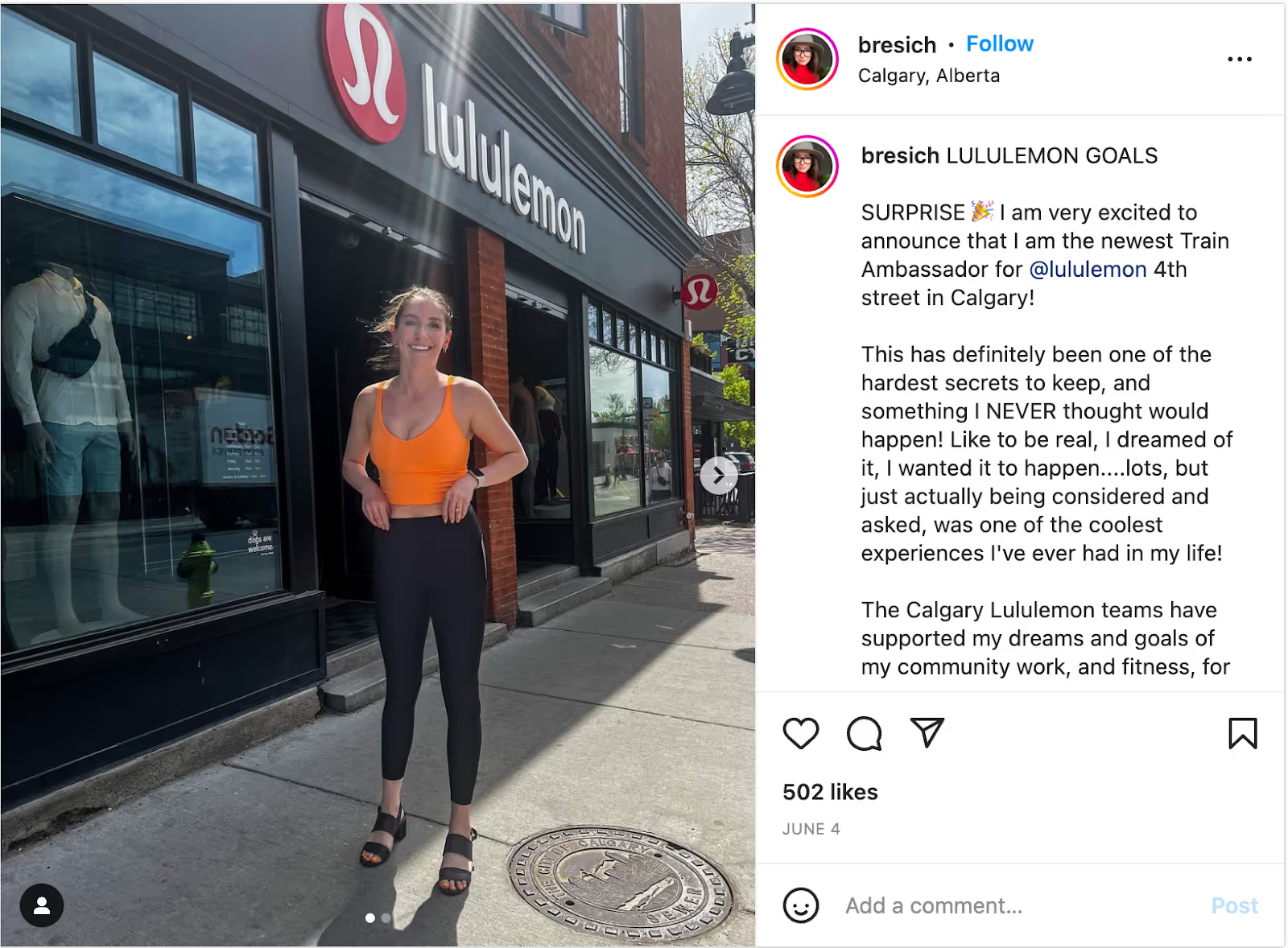
Employees
Got passionate employees on your team? They can be insightful brand ambassadors because they have an inside scoop on the business. Starbucks has a whole Instagram page that shares its partners’ (AKA employees’) stories.

Students
If your customer base includes young students, campus ambassador programs might be perfect for you. Clothing brand, Oh Polly, uses its student ambassador program to collaborate with students on campus and boost sales.
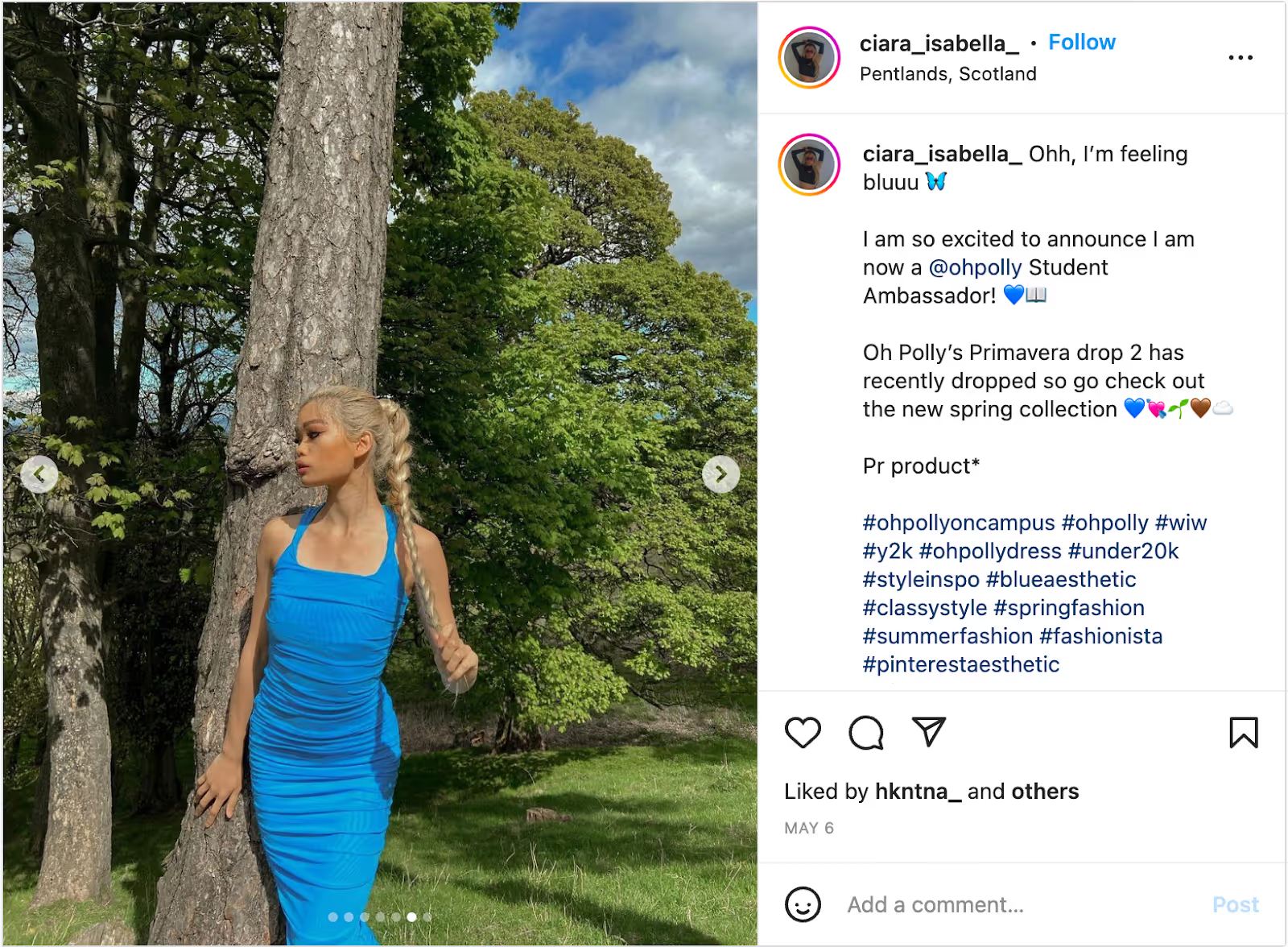
Social media influencers
Influencers who genuinely love your brand can be the best brand ambassadors for your company. They extend your reach to your target audience, form a deeper relationship with your brand, and act as the face of your company. Hair extension brand, Beauty Works, extended its partnership with the influencer Molly Mae and now has a whole collection under her name.
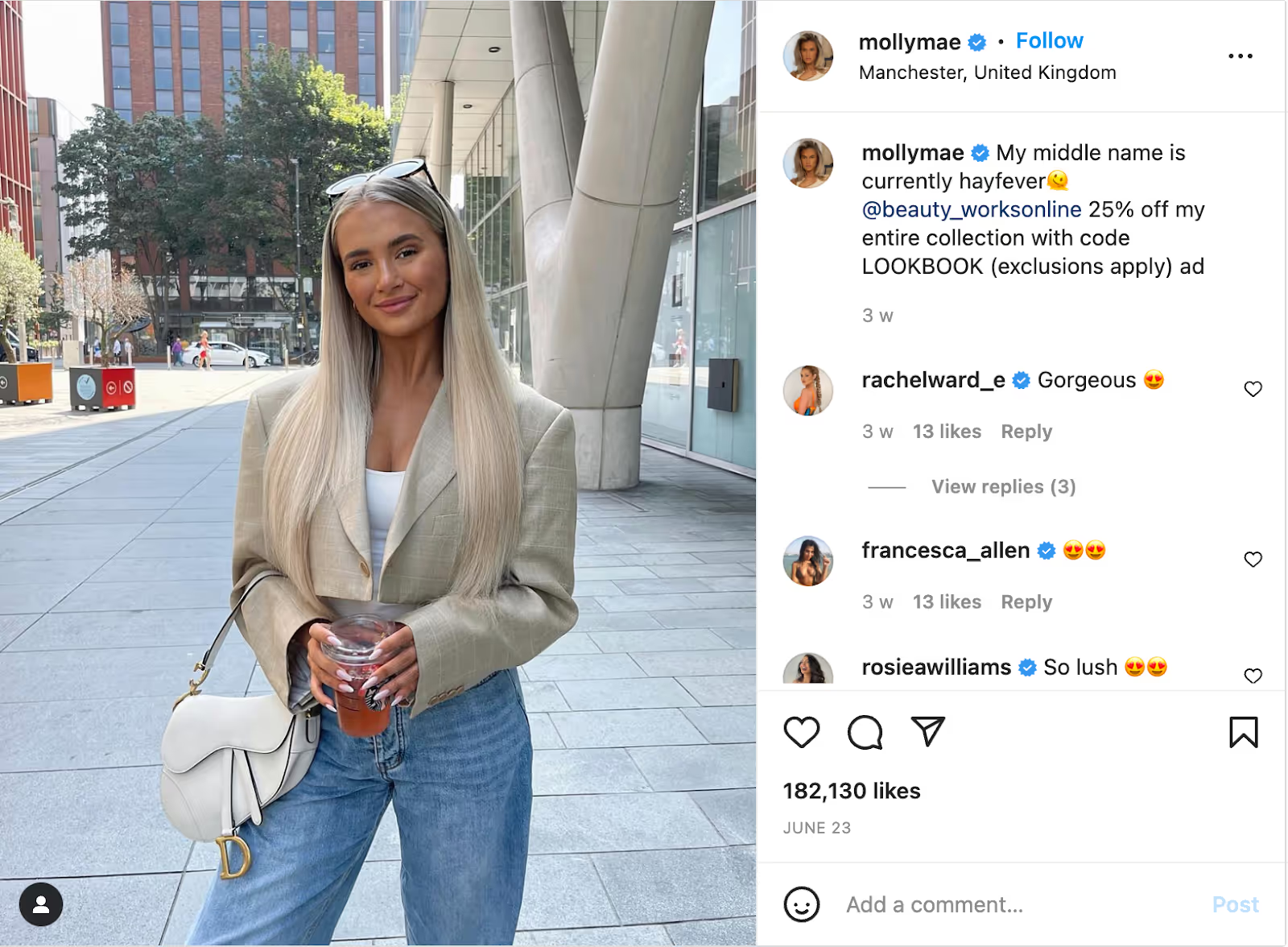
You might notice that there’s quite a bit of an overlap in the job description of a social media influencer and a brand ambassador. But there are significant differences between the two.
What is the difference between a brand ambassador and a social media influencer?
Here are the top characteristics that separate brand ambassadors from influencers:
#1: Commitment
The primary difference between a brand ambassador and an influencer lies in their commitment to your brand.
An influencer typically has a short-term relationship with your company based on a particular timely campaign. On the other hand, a brand ambassador is a long-term advocate and represents your company regardless of whether or not they’re part of an influencer marketing campaign.
For example, hair influencer Emily doesn’t just talk about Peluka Salon repeatedly in her posts but also highlights her ambassador relationship with the company in her Instagram bio.
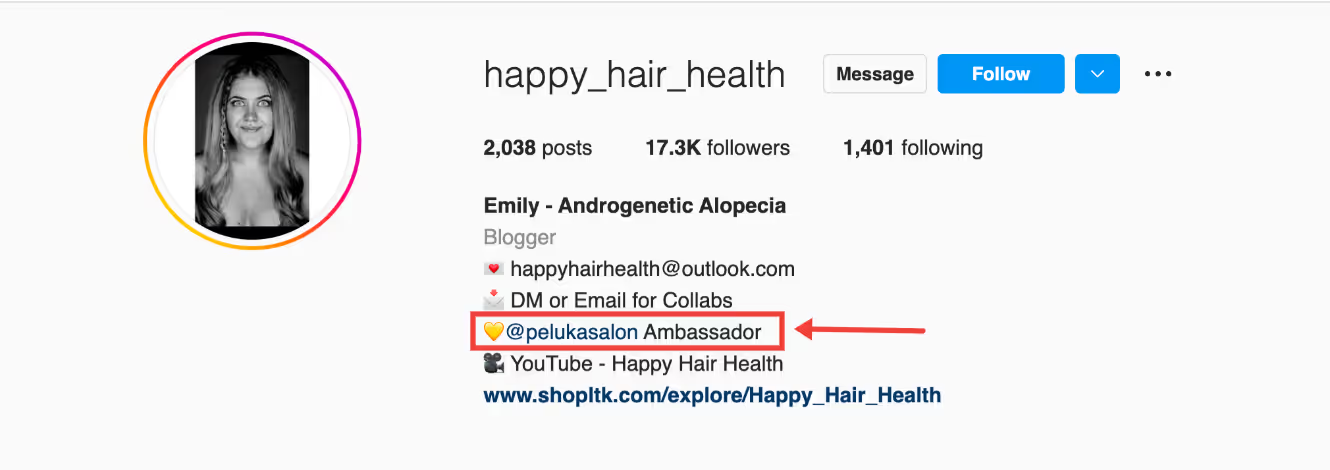
A brand ambassador offers exclusivity, becomes the face of your business, and exemplifies your product every chance they get.
After months of trying a traditional pay-per-post model, Kriptomat started recruiting ambassadors for exactly this reason. Here's what Carl Hallam (CMO) says about their experience in finding brand ambassadors:
We found that our most successful ambassadors were those who built long-term narratives with their communities, establishing trust in our brand rather than promoting a new company every week.
#2: Number of followers
The number of followers doesn’t matter as much for brand ambassadors as influencers. Why? Because for brand ambassadors, the focus is on finding people with a relevant following instead of a large one.
It doesn’t matter if a brand ambassador doesn't have a herd of followers; what counts is they genuinely love your product, are liked and respected in their niche, and align with your brand.
For example, despite having only 1000 followers, Kaylee is the brand ambassador for the jewelry brand Pura Vida. She’s chosen because of her expertise, passion, and commitment to the brand — regardless of her follower count.
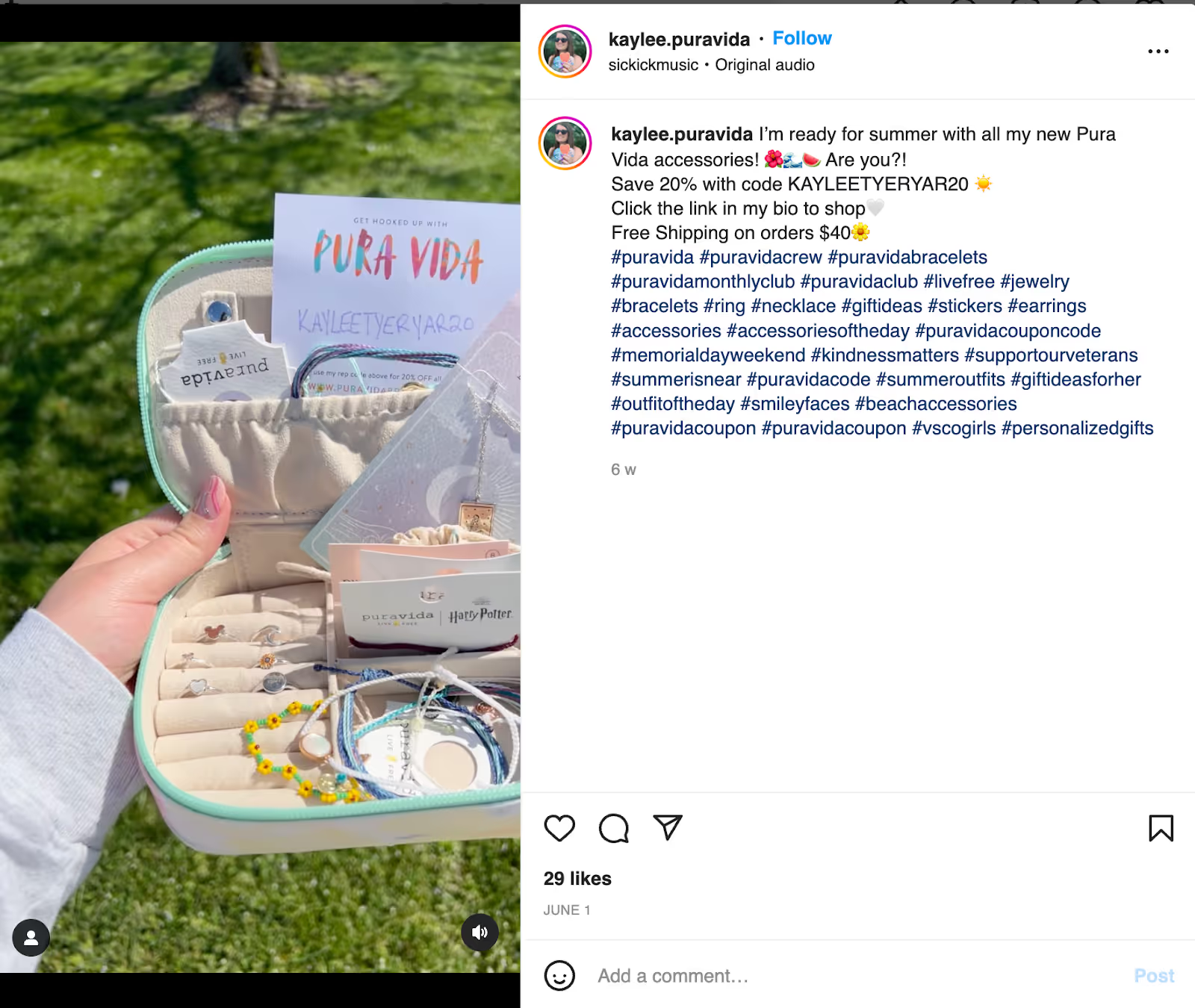
That's not to say that influencers with a smaller following don't have their place too. Using nano & micro influencers is absolutely a viable strategy. The difference is that as influencers, they are chosen based on their ability to influence, regardless of whether or not they are true cheerleaders for your brand.
#3: Authenticity
It’s possible that an influencer doesn’t use your product and hasn’t heard about it before you reached out to them. Influencers might just learn about you and your ethos for one post, done and dust the assignment, and move on to the next brand.
Then it’s no wonder why 47% of consumers are exhausted by repetitive influencer content.
But brand ambassadors are often long-time customers and understand the nuances of your product. They are true believers of your company and align with your brand’s mission.
Ambassador programs are more scalable
Ambassador programs are easy to scale and automate with the right tools under your belt. Even if you add just one brand ambassador per month to your ambassador program, you’ll see compounding growth because of their commitment, authenticity, and love for your products.
But if you try to partner with one influencer per month, you won’t see the same compounding results. There’s no way to experiment with price points, content guidelines, and optimize your spend.
While it might sound like brand ambassadors are a win-win over influencers, brand ambassador programs don’t make sense for every brand.
Should you start a brand ambassador program?
Not all brands are ready to start a brand ambassador program. The model makes sense for your company when:
- You’ve seen some level of success with influencer marketing and want to level up and scale this channel
- More and more customers and influencers are talking about your brand on social media without being asked or paid
- You’ve built an engaged community of customers, employees, or influencers who stand up to your brand values
- You have the workforce to maintain ambassador relationships, campaigns, and commissions
Checking those boxes is a major advantage, but not necessarily a requirement. It's possible to launch an ambassador program earlier in your journey too.
Brand ambassador programs are most popular among e-commerce brands, but they're viable for other models too. Mobile apps & SaaS companies like Sunsama run successful ambassador campaigns.

So, all you need is a decent customer or influencer base who loves your product and are willing to talk about it to their audiences — no matter what industry or niche you’re in.
How to create a brand ambassador program in 7 steps
At this point, you probably see the light. You’re convinced of the power of brand ambassadors and want to start an ambassador program at your own company. Where do you begin?
Let’s look at the seven steps you need to take to start a brand ambassador program:
Step 1: Set specific goals for your brand ambassador program
The biggest mistake you can make is to start an ambassador program without a clear picture of what its success looks like for you.
Setting specific goals help you direct your efforts in the right direction.
Not just this: goals will also help you set clear expectations and requirements from brand ambassadors.
What can goals from your brand ambassador program look like? It’s viable to make sales your primary aim from ambassador campaigns — but remember it might take one to two months to see some attributable revenue from this channel.
Your secondary goals can be PR-related, like brand awareness and increased visibility in your target customers.
⚡Pro-tip: Keep your ambassador program goals aligned with your company’s higher-level goals. For example, if your brand’s goal is to bring in $100,000 in revenue this year, think: What can your brand ambassador program do to ensure the company reaches that goal?
Maybe you can incentivize brand ambassadors with affiliate commissions, so they help you boost sales. Perhaps you can organize events and invite brand ambassadors who can bring in their audiences and attract new customers.
Knowing your objective with the brand ambassador program in advance ensures you partner with the right brand ambassadors who can help you achieve your goals.
Step 2: Formulate a game-plan to implement your brand ambassador program
After laying out your goals, you need a step-by-step process on what you need to do to achieve that objective. Start by answering these questions:
➡️ What tools do you need?
➡️ What’s the budget you need to implement your brand ambassador program?
➡️ How many brand ambassadors do you need?
➡️ What activities do you want your brand ambassadors to do, and how often?
➡️ Which metrics are you going to track to evaluate your progress?
Answering these questions will help you lay out the next steps and assign responsibility to your team.
This will also be the step where you figure out the logistics of the brand ambassador program — what payment method you will use to pay creators, looping in your accounting team to schedule payments to brand ambassadors, and create a contract.
Next, make a brief or a loose list of guidelines for your brand ambassadors. Give them any hashtags they should use, how they should tag you, what discount codes they should always mention, and more. You want ambassadors to remain authentic, but you also don’t want their voice to be completely off from your brand voice.
⚡Pro-tip: Include a step to pay your brand ambassadors a performance-based fee — meaning they get paid based on the number of conversions they bring for your company.
Why? This way, you’ll have increased transparency about how each brand ambassador performs, what’s working, and what needs improvement. It also incentivizes creators since they have a direct stake in increasing your sales.
You can attribute revenue to each brand ambassador using promo codes, affiliate links, and UTM tags.
Step 3: Prepare guidelines, briefs, and perks for your brand ambassadors
After you have a game plan ready, you know what exactly you need from brand ambassadors and what you can offer them in return.
Create a landing page to receive inbound interest from potential ambassadors and save hours on managing the process manually.
Here are the seven elements you need on your ambassador program landing page:
1. Criteria
Make a list of criteria for evaluating potential brand ambassadors and put them on your website.
For example, fashion brand, Amour Boutique, has clearly laid out the qualifications for their ideal brand ambassador: They want someone 18 years or older who loves their company and has over 1,500 followers on their public Instagram profile.

2. Expectations
Highlight the number of posts each ambassador needs to do to weed out creators who can’t post at your ideal frequency.
Fashion company, Backwards Boutique, shares how many Instagram posts and Instagram stories each brand ambassador needs to do every month on their website.

3. Helpful tips
Mention any helpful tips potential brand ambassadors should keep in mind while applying.
For instance, the fashion brand Brooklynn's highlights that they’re looking for ambassadors who are active on stories, post on Instagram often, and genuinely love their products.

4. FAQs and rules
Once your brand ambassador program is up and running, consider adding a frequently-asked-questions box and why a brand ambassador might get eliminated from the program.
Clothing brand Laurie Belles does this well by adding a rules section.

5. Steps to apply
Next, write how potential brand ambassadors can apply to be considered for your program by a quick “how it works” section — mentioning everything from the application link to the timeline of when participants can expect a response.
The clothing company, Revolve, mentions the three-step process for applying to their program and options for payout for ambassadors.
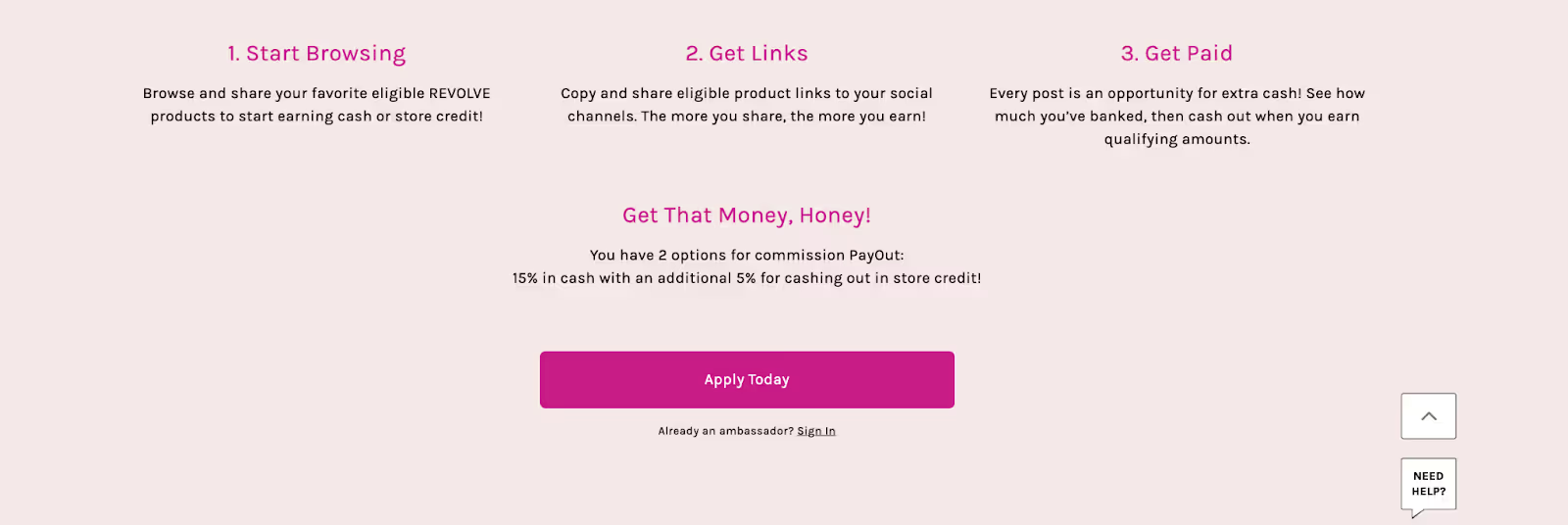
6. Perks
Don’t forget to answer “what’s in it for you” for potential brand ambassadors. Emphasize any and all perks your brand ambassadors get if selected.
Brava Fabrics has an excellent example of what this section should look like.
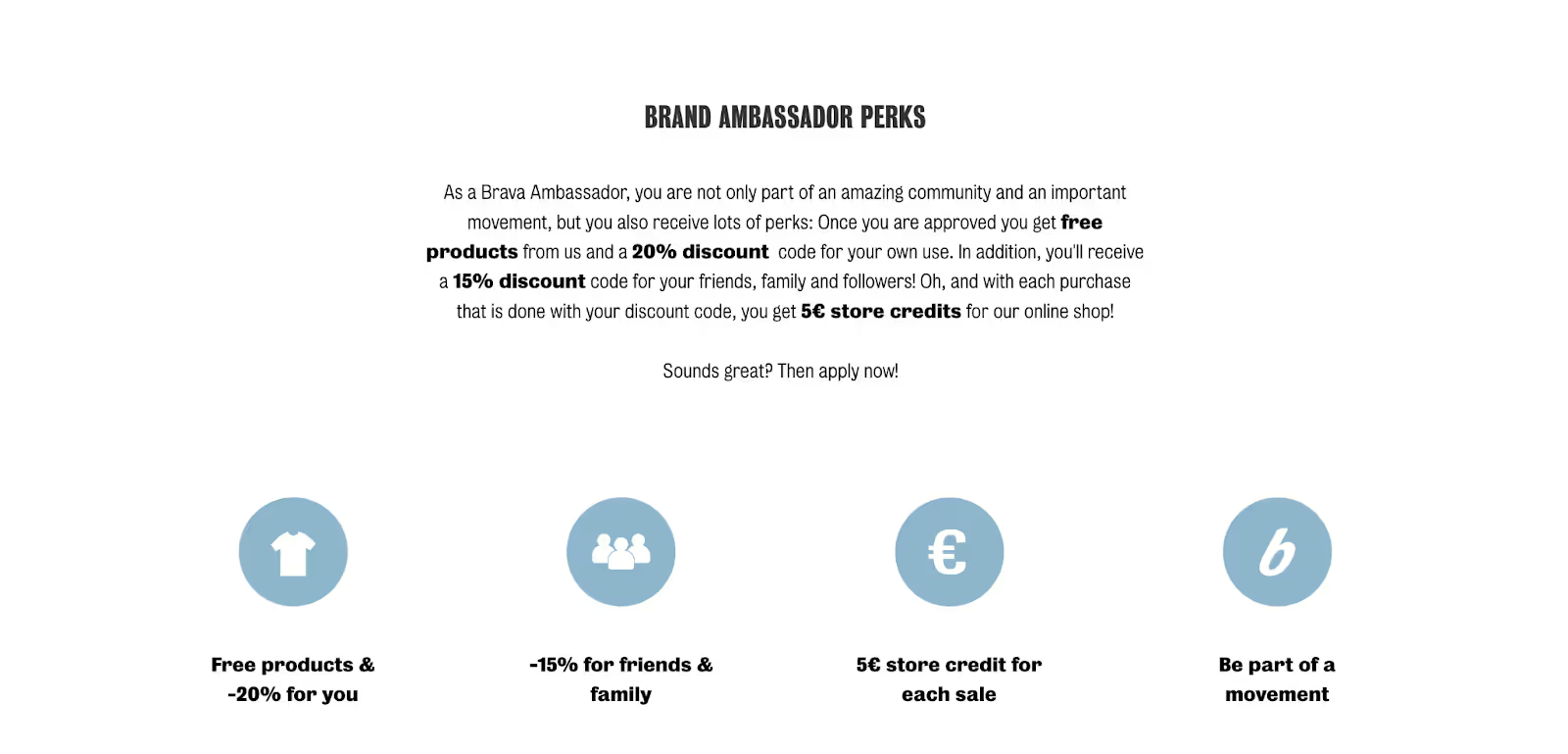
7. Creative brief
If you want to take your landing page up a notch, do what Bolt did: Have a separate content guidelines page for your brand ambassadors to understand your creative brief, help them with talking points, and share examples.
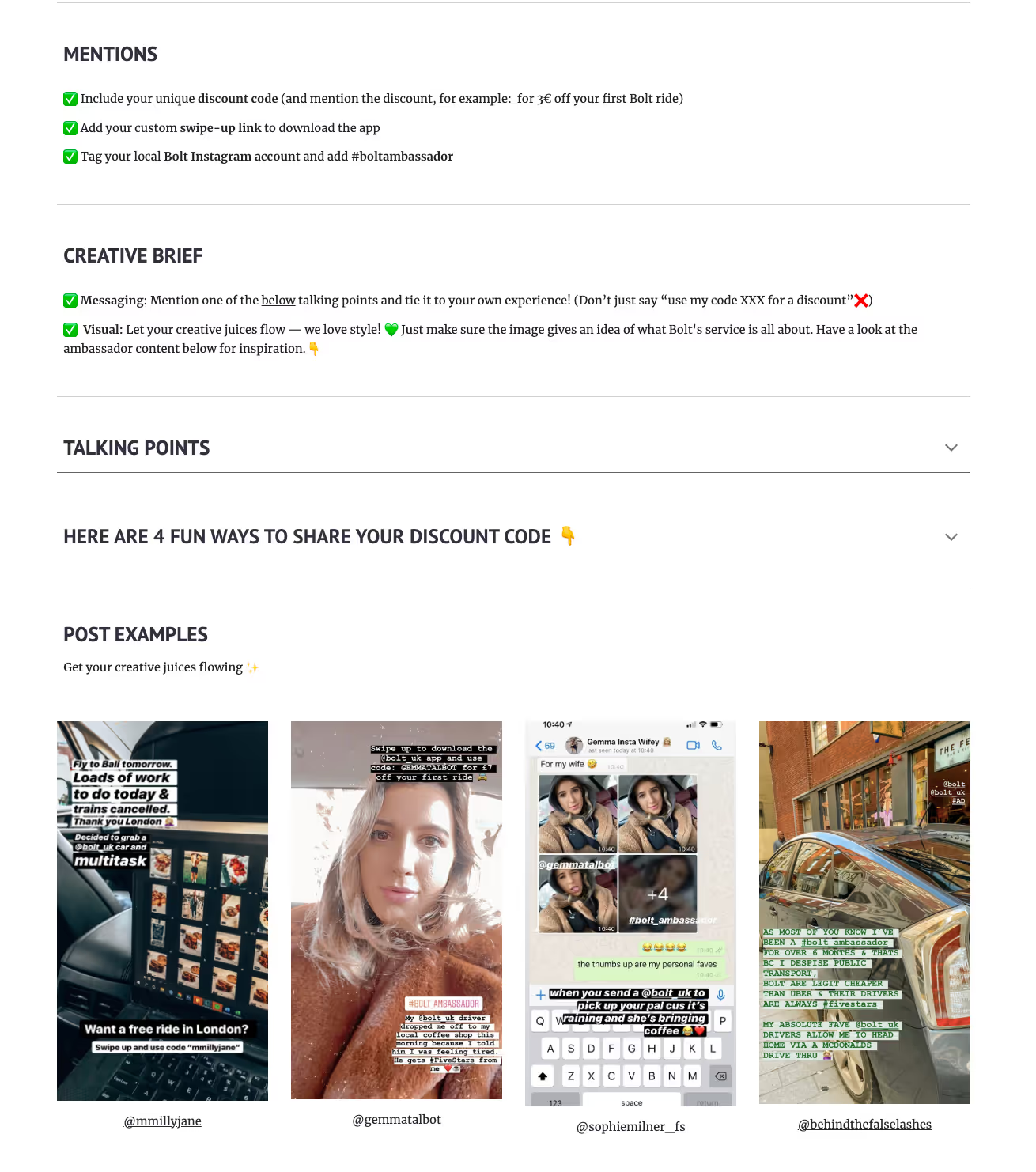
With clarity on your brand ambassador expectations and a thorough game plan, the time has come to get your hands dirty and find some great brand ambassadors.
Step 4: Find and choose the right brand ambassadors
Exclusivity is a big deal in successful brand ambassador programs.
People join brand ambassador programs because they feel a sense of community with your company, agree with your values, and want to contribute to your mission. Everyone isn't cut out to be your brand ambassador — even if they have a hundred thousand followers.
Evaluating an application or an influencer for your brand ambassador program?
Check the following:
➡️ How long have they been your customer or fan?
➡️ Do they engage with your brand on social media and recommend you already?
➡️ How many social media followers do they have?
➡️ What’s the demographic and engagement rate of their social media followers?
➡️ Is their personal brand voice aligned with your brand voice?
Modash is an influencer marketing tool that can help you find prospective ambassadors. Simply search any creator, and you'll get a summary of high-level data like follower count. engagement rate, and popular posts:

More detailed data points are available too, for example:
- If they have fake followers
- Their audience demographics
- Their audience locations
- Recent posts
- Lookalike creators
- Most used hashtags
- ... and more

If you're just starting out though, you might not have a long waiting list of prospective ambassadors to evaluate. You may need to proactively search for ambassadors who could be a good fit. In that case, you can use Modash's discovery tool and apply filters to a database of 200M+ creators.

For instance, let’s say you want a list of brand ambassadors based in Paris, with 1,000 - 100,000 followers, a minimum engagement rate, who is a cyclist. Try searching different hashtags and keywords to find the perfect creators. There's an element of trial and error here.
You can apply similar filters based on creator audiences too - for example, someone with at least 50% of their audience being in France, in certain age ranges.
Having a clear idea of what your ideal brand ambassador looks like helps you weed out people who might not be a good fit.

Step 5: Reach out and negotiate deals with potential brand ambassadors
Often, customers who want to become brand ambassadors will come to you. But other times, you might need to proactively reach out to influencers you’d like to convert into brand ambassadors.
What you write in your cold outreach message would differ based on your brand ambassador program:
- If you’re recruiting customers or students, you’d want to offer discounts and free products to incentivize participation
- If you’re looking to turn existing influencer partnerships to brand ambassador relationships, you need to offer the benefits they get with exclusivity and why they specifically are being asked to join your brand ambassador program
- If you want to collaborate with a new influencer as your brand ambassador, you want to highlight why they’d love your product and what’s in it for them & their audience to partner with you
The key is thinking, “What’s in it for ambassadors?” and making it a point to highlight those advantages in your message.
⚠️ Remember: Build in some negotiation to your deal before sending the offer email.
For example, many successful influencers would be wary of joining a performance-based brand ambassador program. Negotiate with them using an activation fee to kick off the project.
Similarly, if customers don’t appreciate the deal you’re offering, consider increasing the percentage of commission they get per conversion or throwing in another free product.
Flexibility is vital for existing influencer partnerships you want to turn into brand ambassador relationships too — since they already know what works with your audience. It’s easier to extend their collaboration than to negotiate with someone you just met via email.
Step 6: Maintain brand ambassador relationships
Managing ambassador relationships is doable when you have 5-10 brand ambassadors. But what happens when you start to scale and need to maintain more and more partnerships?
Here are some things you can do to make relationship management easier (without recruiting an influencer marketing manager):
- Set a minimum quota: Your brand ambassadors should bring a minimum number of conversions each month to continue staying part of the program. If you find some creators cannot meet this quota consistently, help them or remove them from the brand ambassador program.
- Engage with brand ambassadors on social media: Reshare posts from your brand ambassadors as user-generated content to keep them engaged. Many brand ambassadors are looking to build their social media following and you sharing their posts boosts their online presence. For example, see how Charles Keith reshares their global ambassador, Krystal’s post on their Instagram account.
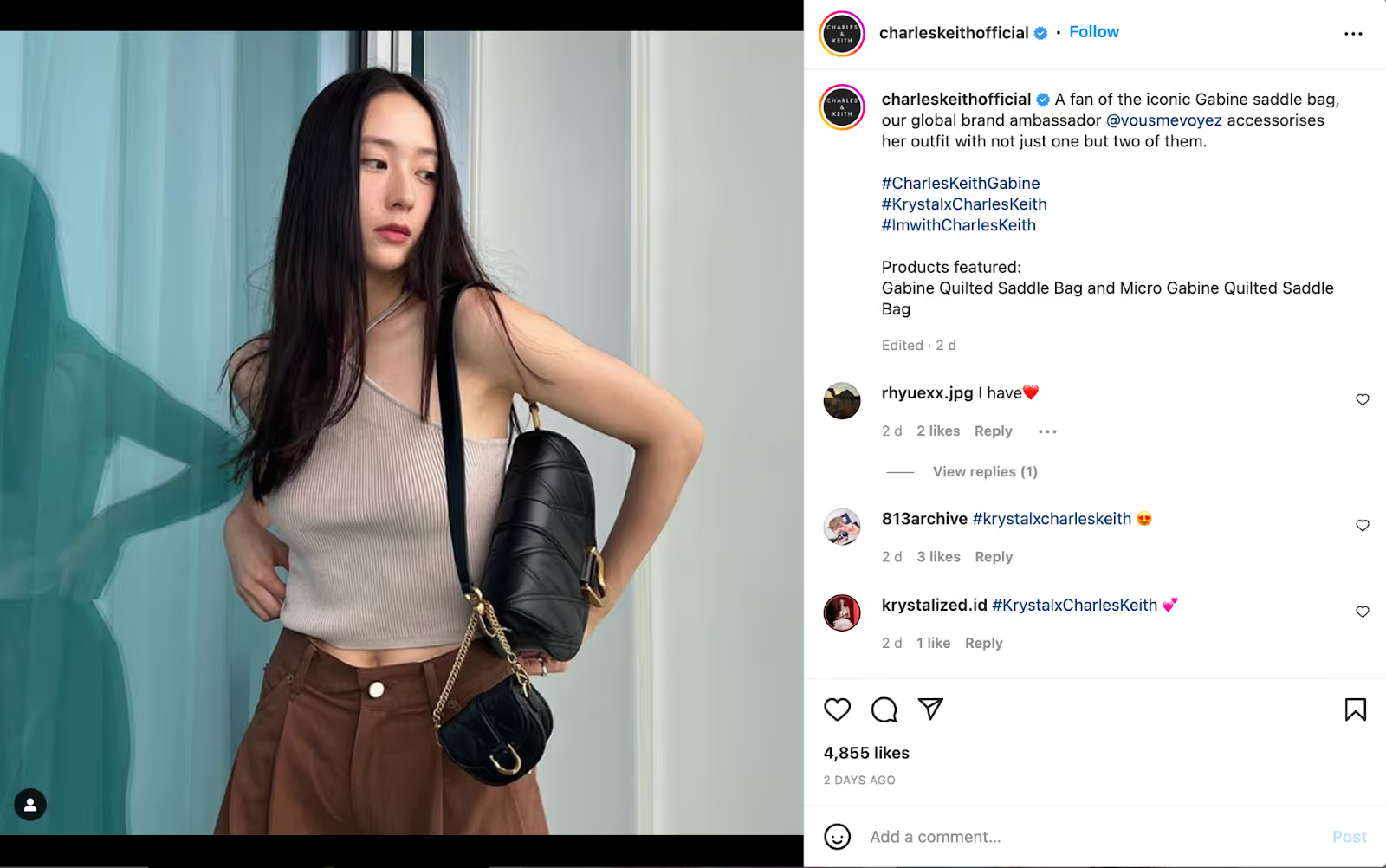
- Monthly newsletters: Have a newsletter that goes out to your brand ambassadors every month. It’ll keep your ambassadors on their toes and help your brand stay on top of mind. You can also use this space to highlight your top brand ambassadors, content that performed well, and share tips for a new brand ambassador post.
⚡Pro-tip: If you have the budget, give your top-performing brand ambassadors a bonus each month along with highlighting their promotions in the monthly newsletter. This would give your brand ambassadors a fresh incentive to work towards and help them understand what kind of content works best for your brand.
For instance, see how Euphoric Herbals talks about the added $50 store gift card for the top brand ambassador in their application.

Step 7: Analyze the data of your brand ambassador program
All marketing efforts require tracking data to determine whether or not something is working and to calculate return on investment.
If you use a performance-based brand ambassador program, tracking your success for each ambassador becomes easier. For example, suppose you’ve given each ambassador a unique coupon code. In that case, you can easily track how many conversions you got from the ambassador’s personalized code in whatever point-of-sales system you use.
Similarly, if you’ve shared trackable unique URLs with brand ambassadors, Google Analytics (or an equivalent) can help you keep a record of UTM links.
This data will help you (as accurately as possible) attribute sales to brand ambassadors and monitor customer behavior.
⚠️ Note: Brand ambassador programs (and influencer marketing in general) tend to be under-attributed.
For instance, a consumer might discover your brand through an influencer and check you out on Google instead of using the brand ambassador’s unique link. So along with keeping an eye on direct conversions, note any indirect boost in traffic and check if any ambassador content might be the spike’s cause.
So how do you keep track of all the content posted about you from various ambassadors and monitor each piece’s performance? Thankfully, you don’t need to request reports or performance data from each ambassador one by one. Nor do you need to screenshot posts & stories every day. Modash can automate this job for you.
Using Modash’s campaign monitoring tool, you can automatically collect every piece of creator content posted by your ambassadors. That means you'll have everything in one place for reporting, repurposing, and analysis. You can see:
- Which ambassadors have posted (and how many times)
- The post creatives (even Stories are saved, before they disappear)
- Post reach & engagements (per post, per ambassador, or per campaign)
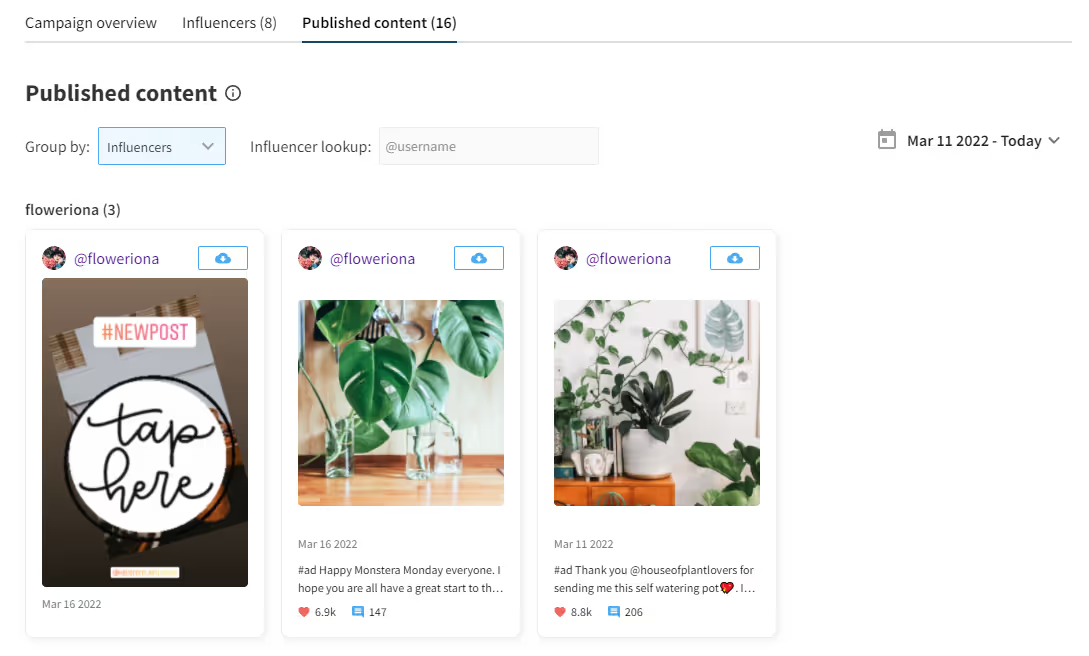
Having all your partner content in one place makes it much easier to spot patterns, and figure out what works best. Let's say an Instagram reel from a brand ambassador drove much more attention than you had predicted. You can see what about this content clicked with people, educate other ambassadors on the formula, and set yourself up for repeatable success.
.avif)
When you nail down your top-performing brand ambassadors, use Modash to find:
➡️ What’s their audience demographic?
➡️ What about their creativity seems to resonate with their audience?
➡️ What’s the frequency with which your top-performers post?
If you spot a pattern, you can double down on it by modifying your ambassador recruitment guidelines, the filters you use to search for ambassadors, and the creative briefs you give.
For example, if you notice that most of your top performers post about your brand 4- 5 times a week, that’s the frequency you can aim for from other brand ambassadors as well. Learn from your best ambassadors, and use that to teach the others & optimize your program.
You can flip this and also analyze your low-performing creators. For example, maybe you observe a trend that all your low-performing brand ambassadors don’t give a clear call-to-action in their posts, which reduces engagement and conversions.
⚡Pro-tip: Share your high-performing pieces and mistakes your low performers make with other brand ambassadors in your monthly newsletter. Why? It’ll inspire their content ideation, generate similar conversion-oriented content, and minimize common mistakes.
And you’re ready to launch your own brand ambassador program!
Brand ambassadors already want your company to succeed. Recruiting them into your official cheerleader gang is the easiest way to take that relationship to the next level and hype up your word-of-mouth in the process. If you’re looking for some inspiration, check examples of some successful brand ambassador programs here.
Remember brand ambassador programs are only successful when you have the right tool stack to recruit the right ambassadors, maintain solid relationships with creators, and track your success.
Modash can help you with all kinds of ambassador programs — whether you’re hiring campus students or doubling down on your best influencers. Find, analyze, and monitor creators like some of the top DTC brands in the world.
Get a 14-day free trial today to see how it works.



